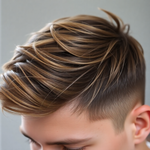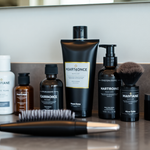
Semi‑Permanent Hair Dye for Men: Strategic Hue Swaps to Cut Clothing Waste and Stretch a Sustainable Capsule Wardrobe
25 September 2025
Share
Struggling to refresh your look without buying new clothes? Try a hue swap instead.
Semi‑Permanent Hair Dye for Men is a simple, low‑risk way to change how your clothes read on you — boosting contrast, warming or cooling your palette, and making the same capsule wardrobe feel like new. In under an hour you can test a new vibe, avoid impulse shopping, and keep your closet lean and sustainable.
Semi‑Permanent Hair Dye for Men: why it matters for your wardrobe
Think of hair color as an invisible layer that affects every outfit you own. A minor change — a warmer brown, an ash tone, or a subtle tint at the tips — shifts perceived contrast and skin undertone, which changes how garments look on you. That single tweak can refresh ten outfits without buying a single new piece. That's the power of strategic hue swaps.
How a hue swap reduces clothing waste and stretches a capsule wardrobe
- Reduce impulse buys: When outfits feel fresh, you won’t feel the pull to replace basics with new trend pieces.
- Extend wearability: Seasonal pieces can be worn longer because your hair color makes them feel current.
- Multipurpose your basics: One sweater can read casual or dressy depending on hair contrast and tone.
- Lower lifetime footprint: Fewer garments bought equals less textile waste over time — a small change in behavior adds up.
For broader context on textile waste and sustainability, see the EPA’s overview on sustainable textile management: EPA — Sustainable Management of Textiles.
Color theory for men — simple rules that actually work
- Warm vs cool palettes: If your capsule consists of earth tones (camel, rust, olive), a warm hair tone (golden brown, warm chestnut) enhances cohesion. If it’s built around cool neutrals (navy, slate, charcoal), an ash or neutral brown keeps outfits crisp.
- Contrast controls formality: High contrast (dark hair, pale shirt) reads sharper — use it when you want a tailored, authoritative look. Low contrast (mid‑tone hair, muted layers) feels relaxed and approachable.
- Accent tints behave like accessories: A temporary blue, burgundy, or pale blonde accent at the tips or underlayer acts like a scarf — it gives a fresh focal point without altering the whole wardrobe.
- Skin undertone matters: Warm skin + warm hair = harmonious glow. Cool skin + cool hair = clean, modern look. Neutral undertones are flexible — experiment.
Choosing the right semi‑permanent shade
- Start subtle: go one level lighter or darker than your natural color for most capsule strategies.
- Avoid extreme lifts at home: very light blondes require bleaching and can damage hair and force constant salon maintenance.
- For first-time changers, pick a shade that complements your most‑worn pieces (the jacket, tee, or knit you wear most).
- If you want a seasonal cycle, plan two shades per year: a warmer tone for fall/winter and a cooler tone for spring/summer.
At‑home application: the full, safe step‑by‑step routine
- Gather gear: semi‑permanent kit, gloves, old towel, wide‑tooth comb, clips, and a timer.
- Patch test: 48 hours before application to rule out allergic reactions.
- Prep hair: Clean, dry, and detangled. Avoid heavy styling products that block even color uptake.
- Mix and measure: Follow kit instructions exactly; short hair needs less product than long hair.
- Section for control: Work in small sections to ensure even coverage — short clips help guide application.
- Apply: Saturate strands evenly. For accents, paint the ends or underlayers only.
- Wait: Most semi‑permanent dyes process in 20–40 minutes; use a timer and check a small strand at the shorter interval to preview color.
- Rinse with cool water: Rinse until runs clear. Avoid shampooing for 24–48 hours where possible to help the color settle.
- Maintain: Use color‑safe, sulfate‑free shampoo and pigmented conditioners to refresh between full applications.
- Log results: Note shade, time, and product so you can replicate or tweak your next swap.
Pro tips for longer color life and healthier hair
- Skip daily shampoos — dry shampoo can stretch color life.
- Always use a UV protectant if you spend time outdoors; sun fades dye faster.
- Use a bond‑building treatment after coloring if you plan frequent swaps.
- Refresh with diluted pigmented conditioner every 2–3 washes instead of recoloring fully.
Style playbook: pairings that make basic pieces perform like new
Below are practical pairings that take a small number of garments and produce clearly different looks by changing hair tone or contrast.
- Warm chestnut hair: Pair with cream henley, olive field jacket, dark brown boots. Same crewneck sweater now reads cozier for weekend dates.
- Ash brown/neutral tone: Wear with navy bomber, white tee, grey chinos for a modern, urban aesthetic — perfect for work‑to‑bar transitions.
- Subtle blue or burgundy tint: Add to the ends and match with monochrome black or navy outfits to create an editorial accent without new clothes.
- Dark natural hair: Gives structure to tailored coats and makes minimal black-on-black looks feel intentional.
Three outfit examples: one capsule, three moods
- Casual weekend: White tee, faded jeans, olive parka. With warm hair it reads rugged and soft; with ash hair it reads fresh and casual.
- Smart casual: Navy knit, grey trousers, leather sneakers. Dark hair increases formality; a subtle lighter tone makes the knit feel lighter and more relaxed.
- Date night: Black shirt, slim dark denim, brown boots. Add a warm tint to warm the face and soften the black, or keep cool tones for a sharper, more contrasted look.
Maintaining hair health while swapping hues
Frequent color changes don't have to mean damaged hair. Use ammonia‑free formulas, bond protectors, and limit heat styling in the first 72 hours after coloring. If you plan multiple swaps per year, incorporate a weekly deep conditioning and a leave‑in treatment to keep hair strong.
Salon vs at‑home: which route fits your goals?
- At‑home: Cheaper, fast, and perfect for subtle shifts. Great if you want to experiment without committing.
- Salon: Better for complex tones, brighter accents, or if you want expert color correction and guidance.
Budgeting and environmental math
Consider this: a decent semi‑permanent kit or a salon top‑up often costs less than a single new jacket. If one hue swap keeps you from buying one extra outer layer per year, you save money and reduce your wardrobe's environmental footprint. Over 2–3 years, a few strategic color swaps can be more sustainable than seasonal shopping sprees.
Safe practices and when to see a pro
- Always patch test.
- If you have scalp irritation, stop and consult a dermatologist.
- Avoid mixing products from different brands unless directed; unexpected chemical reactions are possible.
- See a pro if you want a shade that requires lightening or a dramatic lift.
Real stories from guys who swapped hues
Sam, 29, swapped to a warm espresso brown and cut his weekend shopping by half. He said his olive jacket suddenly matched his face better and he stopped buying new sweaters to chase a warm look. Jordan, 24, used a short blue tint as a midterm experiment; his monochrome basics felt fresh for months and he reported fewer impulse buys after the swap. These aren’t gimmicks — they’re small behavior shifts that change shopping habits.
Frequently asked questions
- How long does semi‑permanent dye last?
- Typically 4–12 washes depending on product and hair porosity.
- Will it damage my hair?
- Less than permanent dye since it doesn’t use strong oxidizers; still use bond protectors if you plan frequent changes.
- Can I go back to my natural color?
- Yes — semi‑permanent fades. The speed depends on shampooing frequency and product type.
Where to get started (quick shopping guide)
- Pick an ammonia‑free semi‑permanent kit from a reputable brand.
- Buy a pigmented conditioner to refresh color between applications.
- Stock basic maintenance: sulfate‑free shampoo, UV protectant spray, and a deep conditioner.
For wardrobe pairings and long‑wear basics that pair well with hue swaps, check Menll.com’s Wardrobe Essentials collection and grooming tools built for everyday use: Menll.com Wardrobe Essentials. Menll.com’s products are designed with durability and sustainability in mind, making them natural partners to a capsule strategy that avoids waste.
Meta for editors (suggested)
Meta title (55 chars): Semi‑Permanent Hair Dye for Men — Stretch Your Capsule Wardrobe
Meta description (155 chars): Learn how semi‑permanent hair dye for men can refresh outfits, reduce clothing waste, and extend a sustainable capsule wardrobe with step‑by‑step tips.
Final thoughts and one quick challenge
Semi‑permanent hair dye for men is a low‑cost, low‑commitment tool to shift how clothes read on you. Use tone and contrast strategically, maintain hair health, and treat hue swaps as a wardrobe hack that prevents unnecessary purchases. Start with one subtle change this month and see how many pieces feel new without leaving your closet.
Which shade will you try first — warm chestnut, ash brown, or a subtle blue accent? Drop your pick in the comments or browse Menll.com’s Wardrobe Essentials to pair your new color with pieces built to last.
Prev post

Semi-Permanent Hair Color: Build an Outfit Matrix to Buy Less and Maximize Your Sustainable Men's Capsule Wardrobe
Updated on 25 September 2025
Next post

Use Semi-Permanent Hair Color to Cut Clothing Waste — Practical Steps to Build a Sustainable Men's Capsule Wardrobe
Updated on 23 September 2025





